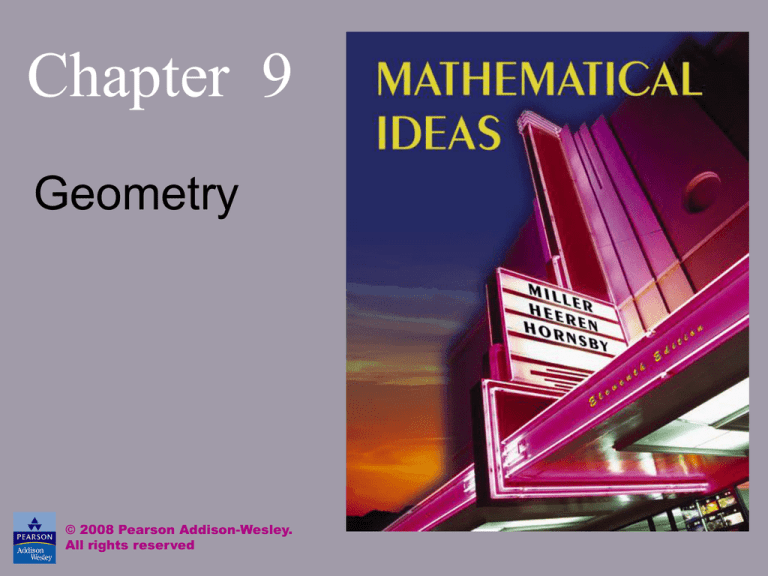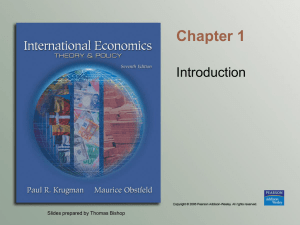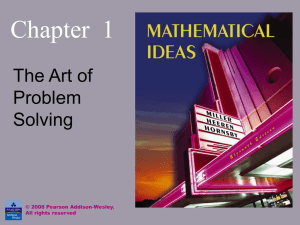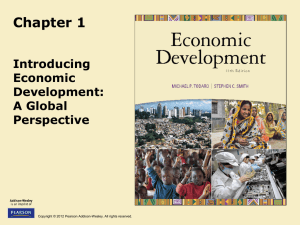
Chapter 9
Geometry
© 2008 Pearson Addison-Wesley.
All rights reserved
Chapter 9: Geometry
9.1
9.2
9.3
9.4
9.5
9.6
9.7
9.8
Points, Lines, Planes, and Angles
Curves, Polygons, and Circles
Perimeter, Area, and Circumference
The Geometry of Triangles: Congruence,
Similarity, and the Pythagorean Theorem
Space Figures, Volume, and Surface Area
Transformational Geometry
Non-Euclidean Geometry, Topology, and Networks
Chaos and Fractal Geometry
9-8-2
© 2008 Pearson Addison-Wesley. All rights reserved
Chapter 1
Section 9-8
Chaos and Fractal Geometry
9-8-3
© 2008 Pearson Addison-Wesley. All rights reserved
Chaos and Fractal Geometry
• Chaos
• Fractals
9-8-4
© 2008 Pearson Addison-Wesley. All rights reserved
Example: Attractor
Consider the equation y = kx(1 – x), with k = 2. This
gives the equation y = 2x(1 – x). We can pick a value
between 0 and 1 and “iterate” the equation by
plugging in the value and then take the resulting yvalue, substitute it in as an x-value in the equation
and continue this process. For example, starting with
x = 0.8 produces the sequence
.8, .32, .435, .492, .500, .500, .500, …
9-8-5
© 2008 Pearson Addison-Wesley. All rights reserved
Attractors
The sequence seems to stabilize at the value .500. A
different x-value would produce another sequence that
“converges” to .500. The value .5000 can be called
an attractor for the sequence generated by the
equation y = 2x(1 – x).
For k = 3, y = kx(1 – x) converges to two attractors,
and for k = 3.5, it converges to four attractors. If k is
increased further, the number of attractors doubles
over and over. This doubling occurs infinitely many
times before k gets as large as 4.
9-8-6
© 2008 Pearson Addison-Wesley. All rights reserved
Chaos
Somewhere before k = 4, the resulting sequence
becomes apparently totally random, with no
attractors and no stability. This type of condition is
one instance of what is known as chaos.
As long as k is small enough, there will be some
number of attractors and the long-term behavior of the
sequence is the same regardless of the initial x-value.
But once k is large enough to cause chaos, the longterm behavior of the system will change drastically
when the initial value is changed only slightly.
9-8-7
© 2008 Pearson Addison-Wesley. All rights reserved
Chaos
Patterns similar to those in the previous sequences
apply to many phenomena in the physical,
biological, and social sciences.
Continuous phenomena are easily dealt with. A
change in one quantity produces a predictable change
in another. (For example, a little more pressure on the
gas pedal produces a little more speed.)
9-8-8
© 2008 Pearson Addison-Wesley. All rights reserved
Catastrophe Theory
Rene Thom, a forerunner of chaos theory, applied
the methods of topology to deal with discontinuous
processes. Thom referred to events with a sudden
change such as a heartbeat, a buckling beam, a stock
market crash, a riot, or a tornado, as catastrophes.
He proved that all catastrophic events are
combinations of seven elementary catastrophes. His
work became known as catastrophe theory.
9-8-9
© 2008 Pearson Addison-Wesley. All rights reserved
Catastrophe Theory
Each of the seven elementary catastrophes has a
characteristic topological shape. Two examples
are shown on the next slide. The top figure is
called a cusp. The bottom figure is an elliptic
umbilicus.
9-8-10
© 2008 Pearson Addison-Wesley. All rights reserved
Example: Elementary Catastrophes
9-8-11
© 2008 Pearson Addison-Wesley. All rights reserved
Fractal Geometry
Fractal geometry provides a key for the new
study of non-linear processes. It is concerned with
figures that exhibit a self-similar shape – a shape
that repeats itself over and over on different scales.
A coastline is an example of a self-similar shape.
The branching of a tree, from twig to limb to trunk
also exhibits a shape that repeats itself. Benoit
Mandelbrot developed much of the work in this
field.
9-8-12
© 2008 Pearson Addison-Wesley. All rights reserved
Fractal Example: Koch Snowflake
Starting with an equilateral triangle, each side
gives to another equilateral triangle. This
process continues over and over indefinitely and
a curve of infinite length is produced.
…
Step 1
See next
slide
Step 2
9-8-13
© 2008 Pearson Addison-Wesley. All rights reserved
Example: Koch Snowflake
9-8-14
© 2008 Pearson Addison-Wesley. All rights reserved
Fractals
The theory of fractals is today being applied to many
areas of science and technology. It has been used to
analyze the symmetry of living forms, the turbulence
of liquids, the branching of rivers, and price variation
in economics.
Aside from providing a geometric structure for
chaotic processes in nature, fractal geometry is
viewed by many as a significant new art form. The
next slide shows a computer-generated fractal design.
9-8-15
© 2008 Pearson Addison-Wesley. All rights reserved
Example: Computer Generated Fractal
9-8-16
© 2008 Pearson Addison-Wesley. All rights reserved







